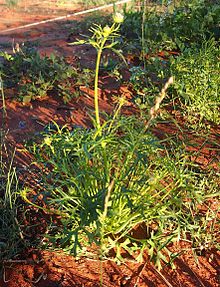
Hakea is a genus of about 150 species of plants in the Family Proteaceae, endemic to Australia. They are shrubs or small trees with leaves that are sometimes flat, otherwise circular in cross section in which case they are sometimes divided. The flowers are usually arranged in groups in leaf axils and resemble those of other genera, especially Grevillea. Hakeas have woody fruit which distinguishes them from grevilleas which have non-woody fruit which release the seeds as they mature. Hakeas are found in every state of Australia with the highest species diversity being found in the south west of Western Australia.

Chamelaucium, also known as waxflower, is a genus of shrubs endemic to south western Western Australia. They belong to the myrtle family Myrtaceae and have flowers similar to those of the tea-trees (Leptospermum). The most well-known species is the Geraldton wax, Chamelaucium uncinatum, which is cultivated widely for its large attractive flowers.

Gastrolobium is a genus of flowering plants in the family Fabaceae. There are over 100 species in this genus, and all but two are native to the south west region of Western Australia.

Mirbelia is a plant genus belonging to the family Fabaceae. It is endemic to Australia, occurring in every mainland state except South Australia.

Thryptomene is a genus of flowering plants in the family Myrtaceae and is endemic to Australia. Plants in the genus Thryptomene are shrubs with small leaves arranged in opposite pairs and white or pink flowers. About forty-seven species of Thryptomene, occurring in all Australian states and the Northern Territory, have been formally described.
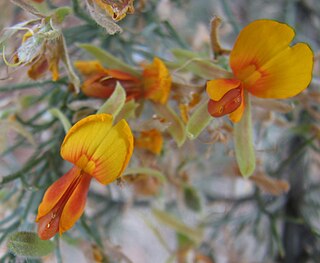
Jacksonia is a genus of about forty, mostly leafless broom-like shrubs or small trees in the flowering plant family Fabaceae. The genus is endemic to Australia and species occur in a range of habitats in all Australian states except South Australia.
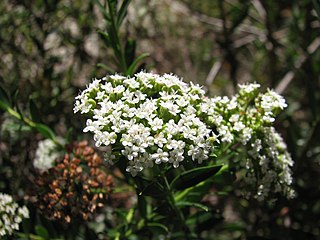
Platysace is a genus of woody perennial herbs and subshrubs in the family Apiaceae. The genus is endemic to Australia.

Xanthosia is a genus of plants of family Apiaceae, but sometimes also placed in Araliaceae or Mackinlayaceae. It comprises 20 species of shrubs endemic to Australia. The habit may also be as a herb. They are found in all Australian states, but not found in the Northern Territory.

Phebalium is a genus of thirty species of shrubs or small trees in the family Rutaceae and is endemic to Australia. The leaves are arranged alternately, simple and often warty, the flowers arranged singly or in umbels on the ends of branchlets or in leaf axils, usually with five sepals, five petals and ten stamens. There are about thirty species and they are found in all Australian states but not in the Northern Territory.
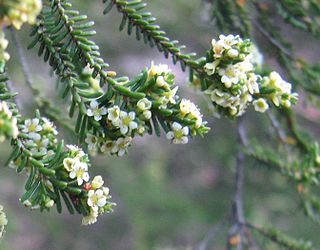
Micromyrtus is a genus of shrubs, in the family Myrtaceae, described as a genus in 1865. The entire genus is endemic to Australia.
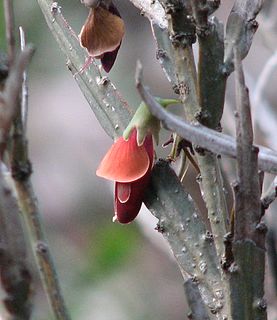
Bossiaea is a genus of about 78 species of flowering plants in the pea family Fabaceae and is endemic to Australia. Plants in this genus often have stems and branches modified as cladodes, simple, often much reduced leaves, flowers with the upper two sepal lobes larger than the lower three, usually orange to yellow petals with reddish markings, and the fruit a more or less flattened pod.

Calocephalus is a genus of flowering plants in the aster family, Asteraceae. It is endemic to Australia, where it is represented in every state.

Tephrosia is a genus of flowering plants in the pea family, Fabaceae. It is widespread in both the Eastern and Western Hemisphere, where it is found in tropical and warm-temperate regions.

Calytrix is a genus of shrubs in the family Myrtaceae described as a genus in 1806. They are commonly known as starflowers. Calytrix are endemic to Australia, occurring in the.
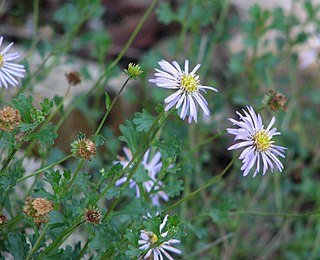
Calotis is a genus of herbs or small shrubs in the daisy family Asteraceae. Most of the species are native to Australia, while two occur in Asia.

Sphaerolobium is a genus of flowering plants in the family Fabaceae. The genus is endemic to Australia, occurring in all states and territories except the Northern Territory.

Isotropis is a genus of flowering plants in the family Fabaceae. The genus is endemic to Australia.
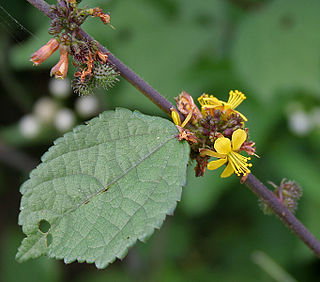
Triumfetta is a genus of plants in the family Malvaceae. Burbark is a common name for plants in this genus.
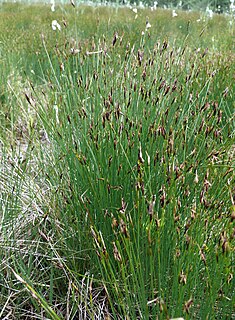
Schoenus is a predominately austral genus of sedges, commonly known as bogrushes, or veldrushes in South Africa. Species of this genus occur mainly in South Africa, Australia and Southeast Asia. Others are found in scattered locations worldwide, from Europe to Asia, North Africa and the Americas. Three species occur in the peatlands of southern South America, including S. antarcticus which is found in Tierra del Fuego, where it forms a component of hyperhumid Magellanic moorland.
